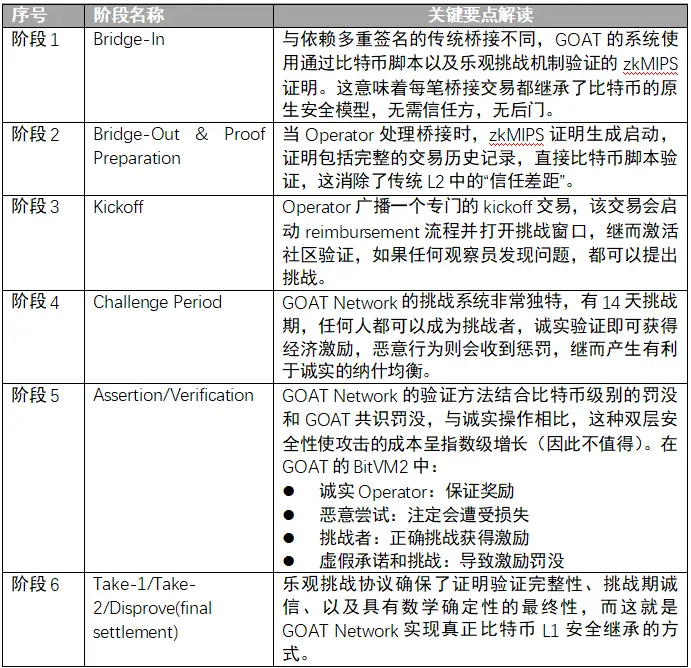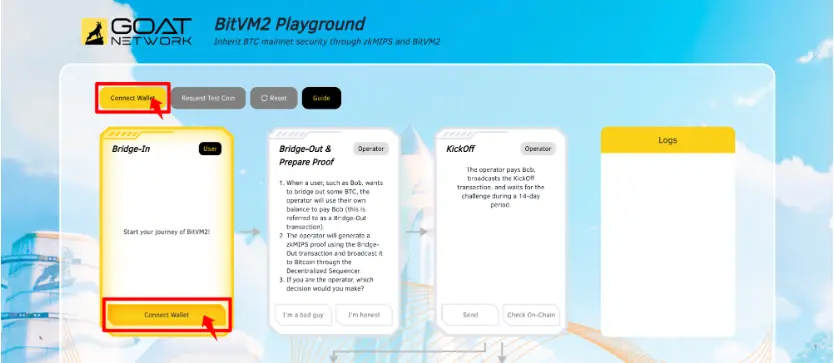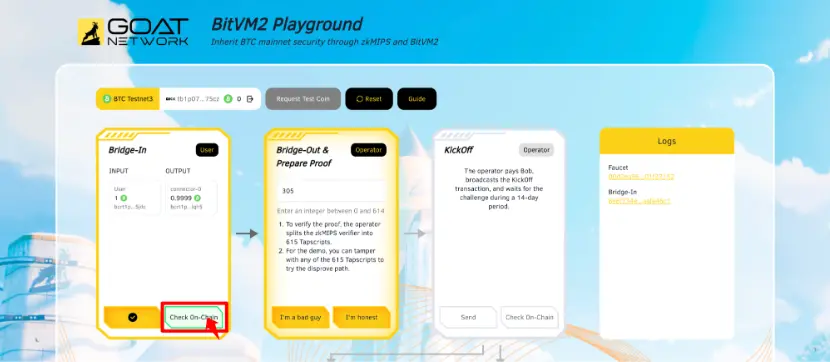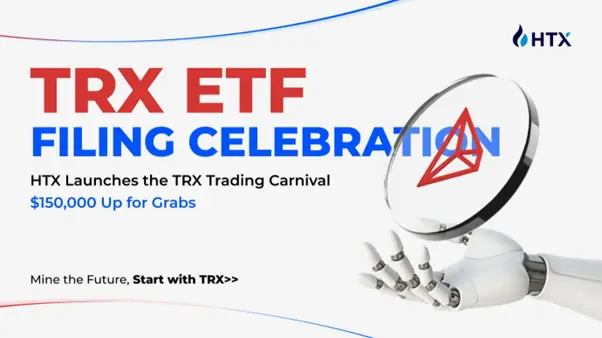BitVM2 Testbed: A Detailed Explanation of How GOAT Network Builds a Native Bitcoin Security Layer
Since the launch of Bitcoin in 2009, it has primarily been viewed as a value storage tool rather than a dynamic blockchain capable of supporting robust layer two networks, due to its original design not being intended for smart contracts and DApps. This has resulted in relatively few on-chain financial use cases and lower ecosystem participation.
Unlike Ethereum, networks like Optimism and Arbitrum have successfully implemented native bridging mechanisms that inherit the security of the Ethereum main chain, while Bitcoin faces numerous challenges in achieving a similar security model. Therefore, projects attempting to establish a similar security model that allows true layer two networks to inherit Bitcoin's layer one security have struggled to materialize. The crypto community needs a more secure way to transact on the Bitcoin network now more than ever—this is precisely where the GOAT Network comes into play.
What is GOAT Network?
GOAT Network is the first decentralized Bitcoin layer two network that shares network ownership, employing a trust-minimized design, a decentralized ordering network, and an optimistic challenge protocol (GOAT-OCP) to ensure trustlessness and security. Unlike the "traditional" model where a foundation controls network operations and generates revenue independently, GOAT Network launches with external sequencer node operators, allowing the community to share block production, transaction ordering responsibilities, and sequencer revenue. Sequencer node operators can earn from Bitcoin while helping to secure the network, as well as from various activities including block production, transaction ordering, and maximum extractable value (MEV).
What sets GOAT Network apart is its ability to allow the entire crypto community (including small holders) to lock BTC into sequencer nodes and earn sustainable returns. Moreover, compared to the Lightning Network, GOAT Network is also compatible with the Ethereum Virtual Machine and supports smart contract functionality—technically, GOAT Network resembles a generalized Bitcoin layer two framework built on ZK technology, utilizing an underlying zkVM general execution layer, an Entangled Rollup Network for shared interactive communication, and a decentralized sequencer shared layer to provide native cross-chain capabilities without cross-chain bridges and a unified liquidity interactive operation center.
In simpler terms, GOAT Network is akin to a "Rollup as a Service" provider within the Ethereum layer two ecosystem, capable of expanding the scale of Bitcoin layer two POS chains through a generalized modular paradigm and providing a sustainable BTC yield economic model to ensure the feasibility of its narrative.
What Role Does BitVM2 Play?
First, let's take a look at what BitVM is.
BitVM is a computational paradigm that leverages the Taproot upgrade to facilitate Turing-complete contracts on Bitcoin without changing the network consensus rules, allowing for verification of computations (rather than execution), similar to optimistic rollups. BitVM does not require a fork or any changes to the Bitcoin protocol and does not congest the Bitcoin blockchain, as computations are not executed on Bitcoin but are verified using the Bitcoin network only in the event of a dispute.
The most significant change brought by BitVM is that it enables programmability on Bitcoin, meaning developers can explore various use cases without altering the core of Bitcoin. BitVM2 is a major upgrade to BitVM, making complex computations on Bitcoin possible. Its core idea is to execute complex computations off-chain while conducting fraud proofs on-chain, akin to playing a "trust game" on Bitcoin, where everyone assumes the computation results are correct, but if someone cheats, anyone can come forward to expose it. This design cleverly achieves Turing-complete computation verification on Bitcoin's limited scripting capabilities, effectively giving Bitcoin a "super brain," which is also decentralized.

Frankly, only by inheriting the native security of Bitcoin can a network be deemed a true Bitcoin layer two. The BitVM2 technology of GOAT Network aims to achieve innovation in Bitcoin layer two networks through a complex proof verification system supported by slashing and plans to integrate it into the future GOAT Bridge, with the goal of inheriting the native security of Bitcoin layer one. Its decentralization and security innovations on BitVM2 are primarily reflected in the following aspects:
- True Decentralization: Through an innovative permissionless decentralized ordering protocol, all cross-chain messages (including asset deposits, withdrawals, and layer two state rollups) will simultaneously gain consensus from both Bitcoin and the GOAT Network layer two network, eliminating reliance on any centralized entity and ensuring true decentralization while simplifying the trust setup of the BitVM2 protocol and providing equivalent security guarantees.
- Full Verification of Bitcoin Without Forks: GOAT employs the most practical BitVM2 protocol, which can directly verify proofs through Bitcoin scripts, inheriting Bitcoin's native security. Thanks to GOAT's cutting-edge zkMIPS infrastructure, this architecture achieves a rapid proof generation and verification process.
- Dual Slashing Mechanism: GOAT has introduced the first dual slashing mechanism for Bitcoin layer two networks. This mechanism combines the local slashing mechanism of the Bitcoin validation layer with the GOAT consensus layer, significantly reducing the likelihood of dishonest behavior within the GOAT Rollup protocol. Potential issues addressed by this model include double signing, node downtime, and illegal refund attacks on GOAT Network's sorting nodes.
It can be said that GOAT Network aims not just to build another bridge but to fundamentally change the crypto community's perception of Bitcoin scalability. The newly launched BitVM2 Playground is a significant step for GOAT Network in inheriting the native security of the Bitcoin network and achieving true layer two status, a goal that no other protocol has yet verifiably accomplished.
BitVM2 Playground: Experience Running BitVM2 to Validate GOAT Network's Effective ZK Proofs
The BitVM2 Playground allows the crypto community to witness verifiable security inheritance, open-source verification, mathematical proofs of security, and true Bitcoin layer two scalability for the first time. The BitVM2 process consists of six key stages, each with specific security guarantees:

Now, let's look at an example:
- Preparation
- Connect a Bitcoin wallet: Currently, GOAT Network supports UniSat Wallet and OKX Wallet.

- Obtain test coins: After receiving BTC test tokens, you can begin your BitVM2 Playground journey.

- Start Experience
Step One Bridge-in: Initiate a Bridge-in transaction, which will be broadcast to the network.
- Click the Send button to open the wallet for signing.

- When the transaction is successful, the Check On-chain button will become clickable, allowing you to view on-chain data.

Step Two Bridge-Out & Prepare Proof: When a user (let's say his name is Bob) wants to bridge some BTC, the operator will use their own balance to pay Bob (known as the bridging transaction). The operator will then generate a zkMIPS proof using the Bridge-Out transaction and broadcast it to the Bitcoin L1 network through GOAT Network's decentralized sequencer.
If you are the operator, what decision would you make?
- If you choose to forge a zkMIPS proof, you need to enter an integer between 0 and 614, then click the button "I'm a bad guy."

- If you have not forged any transactions, you can directly click the "I'm honest" button.

Step Three Kickoff: The operator pays Bob and broadcasts the KickOff transaction, waiting for a 14-day challenge period.
- Click the Send button to open the wallet for signing.

- After the transaction is successful, the Check On-chain button will become clickable, allowing you to view on-chain data.

Step Four (4-1) Take-1: If no challenges occur during the entire 2-week potential challenge period, it indicates that the operator has acted honestly, and they can broadcast the Take-1 transaction.
- Click the Send button to continue.

- Since the operator is trusted, they will broadcast the Take-1 transaction, and the transaction will conclude successfully.

Step Four (4-2) Challenge: Push a challenge transaction that will spend the output of the KickOff transaction (indicating that the operator cannot enter the Take-1 transaction).
- Click the Send button to continue.

- When the transaction is successful, the Check On-chain button will become clickable, allowing you to view on-chain data.

Step Five Assert: The operator must disclose the zkMIPS validator Tapscripts through the Assert transaction; otherwise, they cannot continue to execute the Take-2 path.
- Click the Send button to continue.

- When the transaction is successful, the Check On-chain button will become clickable, allowing you to view on-chain data.

Step Six (6-1) Disprove: If the challenger finds an error in the Tapscript submitted by the operator, they can issue a Disprove transaction, which will execute the corresponding verification subscript to check if it is a valid challenge. If the proof is overturned, the operator will lose the locked BTC, and the challenger can win a reward.
- Click the Send button to perform Disprove.

- The operator did not forge the zkMIPS proof, and the challenge fails, allowing them to continue to Take-2.

- The operator generates a false zkMIPS proof, and the challenge succeeds.

Step Six (6-2) Take-2: If no valid rebuttal actions occur before the end of the two-week rebuttal period, the operator will receive compensation from the GOAT alliance in the Take-2 path and gain some additional rewards.
- Click the Send button to continue.

- When the transaction is successful, the Check On-chain button will become clickable, allowing you to view on-chain data.

It is important to note that the BitVM2 Playground is merely a demonstration, allowing users to see the actual operation of BitVM2 technology and will not create real transactions.
Conclusion
Perhaps everyone enters the crypto industry with different goals; maybe you are not a founder or builder, and perhaps you don't even know how to code, let alone launch a DApp. GOAT Network aims to break these stereotypes, not to work behind closed doors or remain stagnant, but to open the doors wide and take the broad road. Perhaps this is the original intention behind launching the BitVM2 Playground—to allow everyone to try and experience in an engaging way.
On a deeper level, such an intention may support the establishment of a community centered around Bitcoin, an economy focused on Bitcoin, where every interaction helps build a broader consensus, transacting with Bitcoin to power the entire Bitcoin economy.










